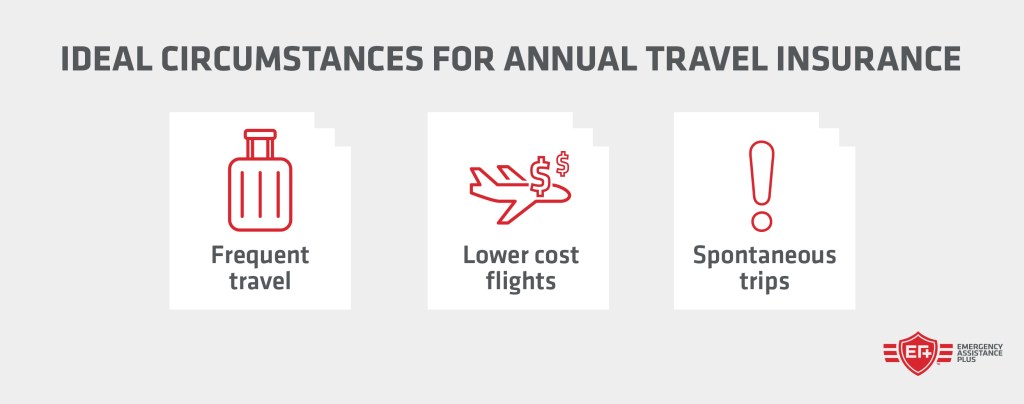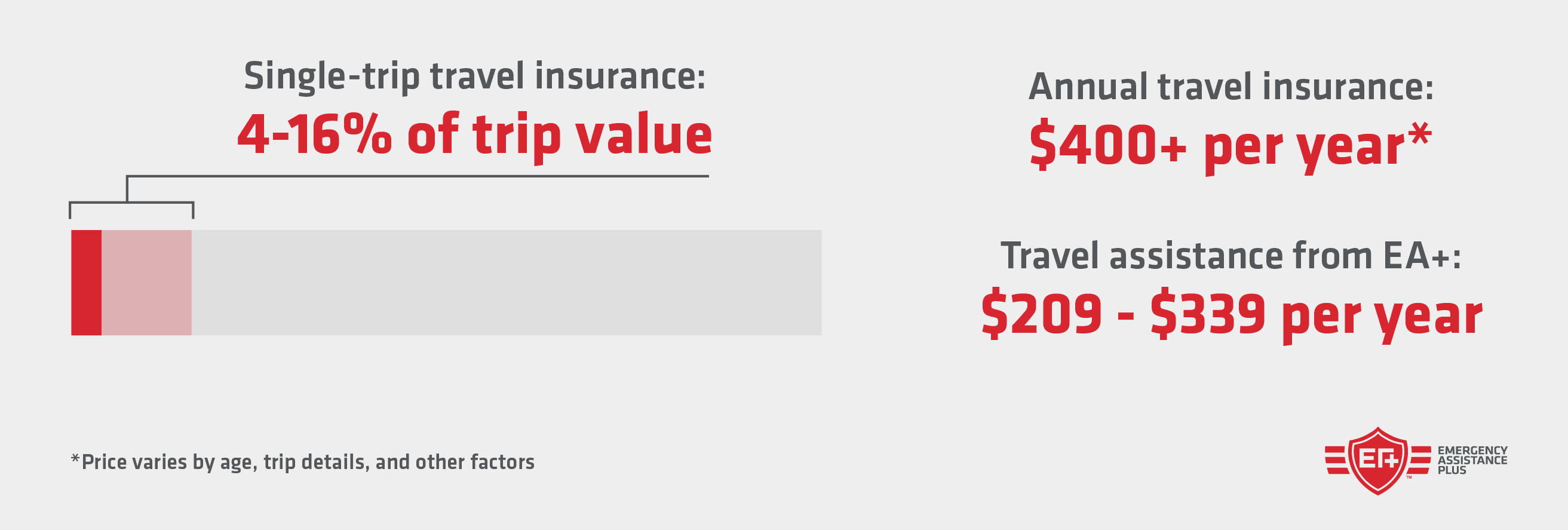A comprehensive look at the details of annual travel insurance, also known as multi-trip insurance.
Published on August 23rd, 2023 in Travel Insurance
If you take multiple trips per year, or plan to, you might have looked into annual travel insurance.
If you’re looking to understand more about annual memberships for travel insurance and related trip/vacation services, you’re in luck. This post provides a comprehensive explanation of the details of annual travel insurance, including:
Additionally, we’ll also provide some general tips for making sure you get the best available support for your trips so you can travel with confidence.
Related reading in case you missed it:
Let’s get started!
What is annual travel insurance?
Annual travel insurance (also called multi-trip insurance) is a type of policy that provides coverage for multiple trips within a specified period; usually one year. Instead of purchasing separate policies for each trip, you pay a single premium for the annual policy, which provides coverage for multiple journeys during that time frame.
Annual travel insurance purchases are on the rise. In 2021, the annual travel insurance segment had the largest market share (58.7%) and market revenue of 7.7 billion (Spherical Insights).

Here are the components of annual travel insurance:
Coverage period
First, the consumer needs to define a desired coverage period. The policy remains in effect for the specified period, usually one year from the date of purchase. During this time, consumers can take multiple trips without needing to purchase separate policies.
Trip duration
Each trip the consumer takes must adhere to the policy’s maximum trip duration. This duration may vary depending on the insurance provider and the specific policy. For example, some policies may allow trips of up to 30 or 60 days, while others might provide coverage for longer durations.
Coverage benefits
Annual travel insurance typically offers a range of coverage benefits, which may include:
Trip cancellation/interruption
Reimbursement for non-refundable trip expenses if your trip gets canceled or cut short due to covered reasons (e.g., illness, accidents, or unforeseen circumstances). This has become an increasingly popular benefit of travel insurance since the sharp increase in disruption of flight schedules the last few years. This is the most popular coverage in travel insurance plans.
‘Cancel For Any Reason’
Abbreviated as CFAR, this coverage benefit supplements basic trip cancellation insurance by allowing people to cancel their trip and receive a partial refund (often around 50% of the total price) for any reason that is not covered in their trip cancellation details.
Emergency medical expenses
Coverage for medical treatment, hospitalization, and emergency medical evacuation while traveling abroad. Keep in mind that consumers will pay out of pocket for these expenses as they’re incurred, then file a claim for reimbursement upon returning home. This is in stark contrast to some travel assistance plans, which arrange the medical care at the time of the emergency at no cost.
Baggage loss or delay
Compensation for lost, stolen, or delayed baggage. Again, consumers will file a claim with the insurance provider once they return home.
Travel delay
Reimbursement for additional expenses incurred due to delayed departures, such as accommodations or meals.
Personal liability
Coverage for legal expenses if a traveler causes injury to someone else or damages their property during a trip.
Other benefits
Policies may also include coverage for accidental death, repatriation of remains, dental emergencies, and more. The specific benefits and coverage limits vary among insurance providers.
Renewal
At the end of the policy period (again, typically one year), consumers have the option to renew their annual travel insurance for another year. Once they pay the premium for the renewal period, the cycle repeats.
Note: Like any insurance policy, annual travel insurance has certain exclusions and limitations. Common exclusions may include pre-existing medical conditions, high-risk activities (e.g., extreme sports), and non-covered destinations (e.g., countries under travel advisories). It’s vital to carefully review the policy’s terms and conditions to understand what is and isn’t covered.
When should you buy annual travel insurance?
There are a few instances where annual travel insurance might be a better fit. This depends on the travel habits and preferences of the individual or family. Here are a few general circumstances when considering purchasing annual travel insurance:

Consumers need to assess travel habits, coverage needs, and compare the costs and benefits of both options before making a decision.
What are the pros and cons of annual travel insurance?
Pros
Cons
How much does annual travel insurance cost?
Should you buy annual travel insurance, single trip travel insurance, or travel assistance?
This is a personal choice and a lot of the decision comes down to the cost of your trip, the type of trip, and your risk tolerance.
That said, we’ll try to provide some pointers.
First, you’re likely going to want to buy a single trip or annual travel insurance policy—not both.
Single trip travel insurance tends to work better for expensive trips that involve air travel. The reason for this is that you can get much more specific in your policy details and protect the costs of individual reservations for flights, hotels, etc.
If you’re planning multiple, lower-cost trips via airplane in the same calendar year, an annual travel insurance policy might be a better bet.
Travel assistance, however, doesn’t really have many overlapping services of either type of travel insurance. While it’s often confused, travel assistance actually provides a far different array of services that are helpful in the moment you need them.
Here’s a story from Theresa and Francis, EA+ customers in New Jersey:
“My husband became very ill in Monument Valley and was airlifted to New Mexico where he was hospitalized for 10 days. During his hospitalization EA+ reviewed his condition, made all flight plans for our travel home, and provided transportation to and from the airports. Most importantly, EA+ provided an experienced (and wonderful!) nurse escort to accompany my husband home. I cannot adequately express how reassuring it was to have the EA+ nurse caring for my husband during our journey home. She monitored his vitals and transported the IV medication he required for the first 48 hours at home. We will NEVER travel without EA+ again.”
Ready to learn more about travel assistance from EA+?
Check out our plan information on our website or give us a call at: 866-863-4460

Should a medical emergency derail your travel, Emergency Assistance Plus® (EA+®) has you protected no matter where you are.
Learn MoreRelated resources

Travel Insurance
Your honeymoon is a cherished experience. Protect it with the right travel insurance coverage, tailored to the unique needs of newlyweds.
Continue Reading
Travel Insurance
Don’t let a pre-existing condition affect your ability to protect yourself on your next trip.
Continue ReadingIf a medical emergency occurs while you’re traveling—either domestically or abroad—you want to know that you and your loved ones are well-protected. Emergency Assistance Plus not only offers that protection but the peace of mind to explore the world with confidence.
